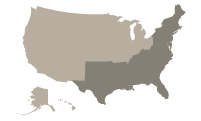
Weakfish
<p>The name “weakfish” refers to the tender, easily-torn membrane of the fish’s mouth, rather than to its fighting ability.</p>

Region
South, Northeast
Catch ease
Easy
Habitat
Bay, Ocean
HOW TO IDENTIFY A WEAKFISH
The lower jaw of the weakfish clearly projects beyond the upper jaw. Two large, recurvate canine teeth in the front of the upper jaw stand out noticeably. The first dorsal fin has 10 spines. The second has one spine and 26-29 soft rays. The anal fin has two spines and 11-12 rays. The scales are ctenoid and extend onto the soft dorsal and anal fins. In the similar looking spotted seatrout (Cynoscion nebulosus) the scales do not extend onto the fins. Also, there are 11-13 gill rakers on the lower limb of the first gill arch in the weakfish, but only 8-9 in the spotted seatrout. Numerous small spots of black, olive or bronze are set close together on the upper flanks of the weakfish and seem to form wavy diagonal lines. The spots do not extend onto the tail or the second dorsal fin as they do in the spotted seatrout, nor are they as large or as widely spaced. There is sometimes a black margin on the tip of the tongue.
WHERE TO CATCH WEAKFISH
The weakfish inhabits the western Atlantic Ocean from Florida to Massachusetts with isolated records of it occurring as far north as Nova Scotia. The centers of abundance are from North Carolina to Florida in the winter and from Delaware to New York in the summer. It is a schooling fish that occurs inshore over sandy bottoms in the summer and in deeper water, up to 330 feet in the winter. It may be found in the surf, in the bays, or in estuaries of rivers and creeks, but does not venture into fresh water. The following list includes additional details on where to catch this fish:
| Bays and Estuaries |
| Breakers |
| Cliffs |
| Deep Shore Water |
| Man-Made Structures |
| Night Fishing |
| Rip Tides |
| Rocky Sea Floor |
| Schools |
| Surf and Shore |
| Saltwater Weed Beds |
How to catch Weakfish
The weakfish is omnivorous and feeds on crabs, shrimp, other crustaceans, mollusks and small fishes like herring, menhaden, silversides, killifish and butterfish which it may catch in midwater or at the surface. These fish may be taken at any level from the bottom to the surface by chumming from a drifting or anchored boat or by trolling, jigging, or surf fishing. Conventional, spinning, and fly tackle may be used. They may also be taken from bridges, docks, and piers. When hooked on light tackle the weakfish is prone to give a long initial run with sudden, unpredictable changes in direction. It is reputed to be the gamest species of the Cynoscion genus. The following are fishing methods used to catch this fish:
Weakfish lures, tackle & bait
The following are lures, tackle or bait that can be used to catch this fish:
